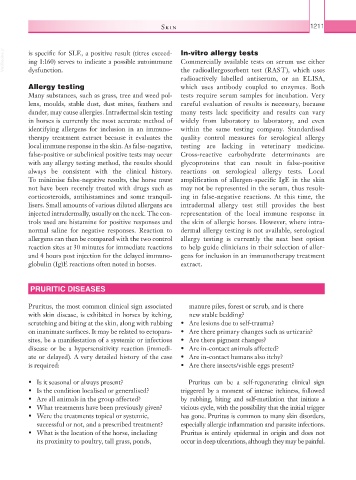Page 1236 - Equine Clinical Medicine, Surgery and Reproduction, 2nd Edition
P. 1236
Skin 1211
VetBooks.ir is specific for SLE, a positive result (titres exceed- In-vitro allergy tests
Commercially available tests on serum use either
ing 1:160) serves to indicate a possible autoimmune
the radioallergosorbent test (RAST), which uses
dysfunction.
radioactively labelled antiserum, or an ELISA,
Allergy testing which uses antibody coupled to enzymes. Both
Many substances, such as grass, tree and weed pol- tests require serum samples for incubation. Very
lens, moulds, stable dust, dust mites, feathers and careful evaluation of results is necessary, because
dander, may cause allergies. Intradermal skin testing many tests lack specificity and results can vary
in horses is currently the most accurate method of widely from laboratory to laboratory, and even
identifying allergens for inclusion in an immuno- within the same testing company. Standardised
therapy treatment extract because it evaluates the quality control measures for serological allergy
local immune response in the skin. As false- negative, testing are lacking in veterinary medicine.
false-positive or subclinical positive tests may occur Cross-reactive carbohydrate determinants are
with any allergy testing method, the results should glycoproteins that can result in false-positive
always be consistent with the clinical history. reactions on serological allergy tests. Local
To minimise false-negative results, the horse must amplification of allergen- specific IgE in the skin
not have been recently treated with drugs such as may not be represented in the serum, thus result-
corticosteroids, antihistamines and some tranquil- ing in false-negative reactions. At this time, the
lisers. Small amounts of various diluted allergens are intradermal allergy test still provides the best
injected intradermally, usually on the neck. The con- representation of the local immune response in
trols used are histamine for positive responses and the skin of allergic horses. However, where intra-
normal saline for negative responses. Reaction to dermal allergy testing is not available, serological
allergens can then be compared with the two control allergy testing is currently the next best option
reaction sites at 30 minutes for immediate reactions to help guide clinicians in their selection of aller-
and 4 hours post injection for the delayed immuno- gens for inclusion in an immunotherapy treatment
globulin (Ig)E reactions often noted in horses. extract.
PRURITIC DISEASES
Pruritus, the most common clinical sign associated manure piles, forest or scrub, and is there
with skin disease, is exhibited in horses by itching, new stable bedding?
scratching and biting at the skin, along with rubbing • Are lesions due to self-trauma?
on inanimate surfaces. It may be related to ectopara- • Are there primary changes such as urticaria?
sites, be a manifestation of a systemic or infectious • Are there pigment changes?
disease or be a hypersensitivity reaction (immedi- • Are in-contact animals affected?
ate or delayed). A very detailed history of the case • Are in-contact humans also itchy?
is required: • Are there insects/visible eggs present?
• Is it seasonal or always present? Pruritus can be a self-regenerating clinical sign
• Is the condition localised or generalised? triggered by a moment of intense itchiness, followed
• Are all animals in the group affected? by rubbing, biting and self-mutilation that initiate a
• What treatments have been previously given? vicious cycle, with the possibility that the initial trigger
• Were the treatments topical or systemic, has gone. Pruritus is common to many skin disorders,
successful or not, and a prescribed treatment? especially allergic inflammation and parasite infections.
• What is the location of the horse, including Pruritus is entirely epidermal in origin and does not
its proximity to poultry, tall grass, ponds, occur in deep ulcerations, although they may be painful.

